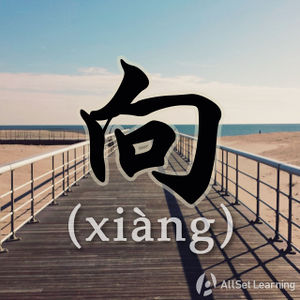Comparing "chao" "xiang" and "wang"
-
Level
-
Similar to
-
Used for
-
Keywords
All three of these, 朝 (cháo), 向 (xiàng), and 往 (wǎng) can be used to indicate direction or position. When these preposition phrases are used before a verb, the three have the same structure and their meaning is the same. You can often swap them in and out. At other times, however, they are used differently, and this article will help you differentiate when you are supposed to use which one.
Contents
When using "朝," "向," and "往" is appropriate
Structure
Just put one of the three before the direction and the verb!
向 / 朝 / 往 + 具体方向 + Verb
Examples
- 从 这里 向 / 朝 / 往 北 走 两 百 米 就 到 了。From here, go one hundred meters north, and you'll get there.
- 这 个 小 女孩 向 左 看看 又 向 右 看看 才 过 马路。This little girl looked left and then looked right before crossing the street.
- 我 看见 他 朝 你们 家 去 了。I saw him going towards your house.
- 往 前 走 十 分 钟。Walk forward for ten minutes.
When to use "向" and "往"
向 and 往 can be placed after the verb, however it has to be used with an appropriate verb, Often used verbs are 开, 飞, 发, 运, 送, 寄, 带, 驶 etc. As you can see, these are words that at least imply some sort of motion. In addition, compared to 向, 往 is used more often with those verbs, because 往 expresses the destination while 向 merely expresses a direction, 朝 cannot be used this way.
Structure
Verb + 向 / 往 + 具体方向
Examples
- 这 趟 火车 开 往 沈阳。This train is heading towards Shenyang.
- 这 趟 航班 飞 往 纽约。This plane is flying to New York.
- 一 辆 黑 色 的 小 轿车 慢慢地 从 东 驶 向 西。The black limo slowly went from East to West.
- 像 鸟儿 一样 飞 向 蓝天。The little birds flew towards the sky.
When to use "向" and "朝"
When the action that takes place is specified to a specific target, use 向 or 朝. 往 cannot be used this way. Also, when the verb is a concrete action, the use of 向 and 朝 are the same, and they can be interchanged.
Structure
向 / 朝 + 动作的对象 + 具体意义的动词
Examples
- 他 向 / 朝 我 笑 了 笑。He laughed at me.
- 我 朝 他 开 了 一 枪。I shot a gun at him.
- 他 已经 向 全体 员工 解释 过 了。He has already explained it to the employees.
When to use just "向"
When the verb has an abstract meaning, you can only use 向, and you cannot use 朝.
Structure
向 + Direction + Abstract Verb
Examples
- 他 是 优秀 员工,我们 都 要 向 他 学习。 He is an exemplary employee, we should all study him.
- 我们 要 向 环保 部门 要求 严查 工厂 排污。We are going to make the Environmental Safety Department closely examine the factory sewage.
Examples of right and wrong sentences
- 这 个 地铁 是 开 往 浦东 机场 的 吗 ?Is this subway heading towards Pudong Airport?
- 你 要 多 向 他 学习 学习 。You need to go to him to learn.
- 帅哥 朝 我 笑 了 一下 。When the handsome guy headed my way I smiled.
- 你 现在 是 开 朝 市 中心 吗?
- 朝 雷锋 同志 学习!
- 往 雷锋 同志 学习!
- 帅哥 往 我 笑 了。
Example dialog
- A: 他 往 南 走 了 。He walked south.
- B: 你 怎么 让 他 往 南 走 呢 ?南 边 很 危险 。Why did you make him go south? Going south is dangerous.
- A: 你 朝 我 发 什么 火?我 说 了 他 不 听 。Why are you mad at me? I told him but he didn't listen
- B: 不好意思 ,我 应该 向 你 道歉 。I'm sorry. I should apologize to you.
See Also
Sources and further reading
Books
- 现代汉语八百词(增订本) (pp. 196) [ →buy]
- 现代汉语虚词例释 (pp. 79, 505) 卓越汉语-公司实战篇 →buy







